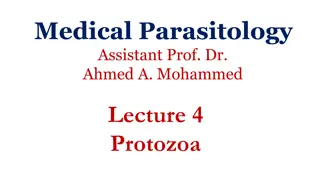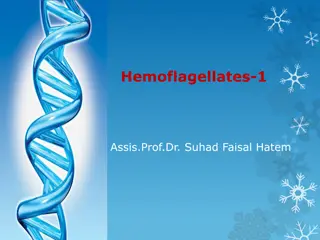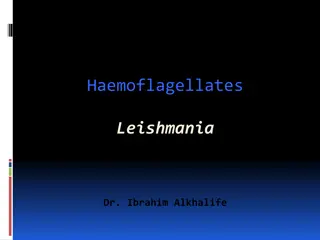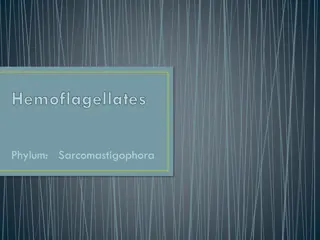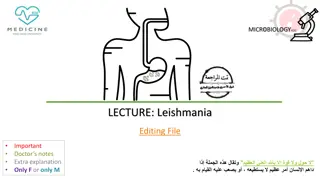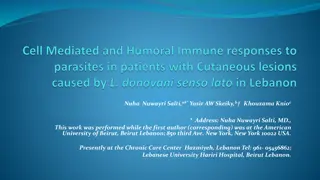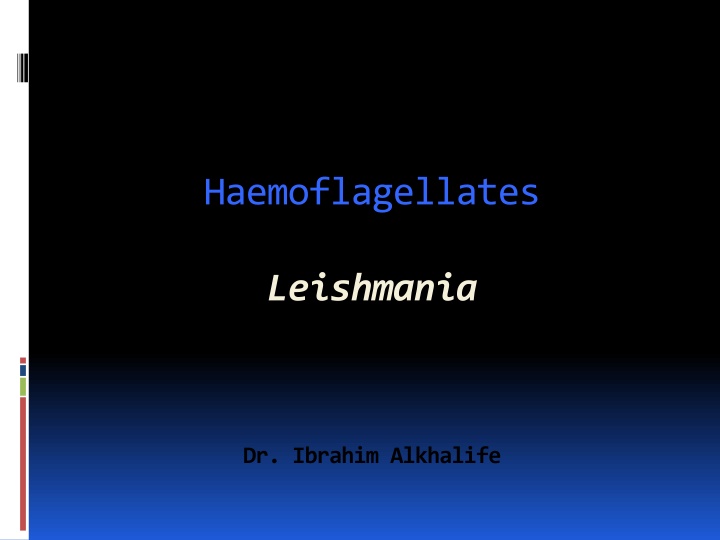
Haemoflagellates: Leishmania Parasites and Diseases
Dive into the world of haemoflagellates with a focus on Leishmania parasites and diseases. Explore different stages of haemoflagellates, the life cycle of Leishmania, clinical types of cutaneous leishmaniasis, and more. Discover species, diseases, and the global distribution of visceral leishmaniasis. Images and descriptions included.
Download Presentation

Please find below an Image/Link to download the presentation.
The content on the website is provided AS IS for your information and personal use only. It may not be sold, licensed, or shared on other websites without obtaining consent from the author. If you encounter any issues during the download, it is possible that the publisher has removed the file from their server.
You are allowed to download the files provided on this website for personal or commercial use, subject to the condition that they are used lawfully. All files are the property of their respective owners.
The content on the website is provided AS IS for your information and personal use only. It may not be sold, licensed, or shared on other websites without obtaining consent from the author.
E N D
Presentation Transcript
Haemoflagellates Leishmania Dr. Ibrahim Alkhalife
Promastigotes of Leishmania Amastigote of Leishmania
Leishmania Parasites and Diseases SPECIES Disease Leishmania tropica* Leishmania major* Leishmania aethiopica Leishmania mexicana Cutaneous leishmaniasis Leishmania braziliensis Mucocutaneous leishmaniasis Leishmania donovani* Leishmania infantum* Leishmania chagasi Visceral leishmaniasis * Endemic in Saudi Arabia
Clinical types of cutaneous leishmaniasis Leishmania major: Zoonotic cutaneous leishmaniasis, wet lesions with severe reaction Leishmania tropica: Anthroponotic cutaneous leishmaniasis, dry lesions with minimal ulceration Oriental sore (most common) classical self-limited ulcer
CUTANEOUS LISHMANIASIS THE COMMON TYPE This starts as a painless papule on exposed parts of the body, generally the face. The lesion ulcerates after a few months producing an ulcer with an indurate margin. In some cases the ulcer remains dry and heals readily (dry-type-lesion). In some other cases the ulcer may spread with an inflammatory zone around, these known as (wet-type-lesion) which heal slowly.
UNCOMMON TYPES OF CUTANEUS LISHMANIASIS Diffuse cutaneous leishmaniasis (DCL): Caused by L. aethiopica, diffuse nodular non-ulcerating lesions, seen in a part of Africa, people with low immunity to Leishmaniaantigens. Diffuse cutaneous (DCL), and consists of nodules and a thickening of the skin, generally without any ulceration, it needs numerous parasite. Leishmaniasis recidiva (lupoid leishmaniasis): Severe immunological reaction to leishmania antigen leading to persistent dry skin lesions, few parasites.
Diffuse cutaneous leishmaniasis (DCL) Leishmaniasis recidiva
Mucocutaneous leishmaniasis The lesion starts as a pustular swelling in the mouth or on the nostrils. The lesion may become ulcerative after many months and then extend into the naso-pharyngeal mucous membrane. Secondary infection is very common with destruction of the nasal cartilage and the facial bone.
cutaneous & muco-cutaneous leishmaniasis Diagnosis The parasite can be isolated from the margin of the ulcer. A diagnostic skin test, known as Leishmanin test (Montenego Test), is useful. Smear: Giemsa stain microscopy for LD bodies (Leishman-Donovan bodies, amastigotes). Skin biopsy: microscopy for LD bodies or culture in NNN medium for promastigotes.
Treatment No treatment self-healing lesions Medical: o Pentavalent antimony (Pentostam), Amphotericin B o Antifungal drugs o +/-Antibiotics for secondary bacterial infection. Surgical: o Cryosurgery o Excision o Curettage REFERENCE :WHO (2010) Control of leishmaniasis. Report of a meeting 571 of the WHO expert committee on the control of leishmaniasis. http://whqlibdoc.who.int/trs/WHO_TRS_949_eng.pdf
Visceral leishmaniasis There are geographical variations. The disease is called kala-azar Leishmania infantummainly affect children Leishmania donovani mainly affects adults The incubation period is usually 4-10 months. The early symptoms are generally low grade fever with malaise and sweating. In later stages, the fever becomes intermittent and their can be liver enlargement or spleen enlargement or hepatosplenomegally because of the hyperplasia of the lymphoid macrophage system.
Presentation Fever Splenomegaly, hepatomegaly, hepatosplenomegaly Weight loss Anaemia Epistaxis Cough Diarrhoea
Untreated disease can be fatal After recovery it might produce a condition called post kala-azar dermal leishmaniasis (PKDL)
Fever 2 times a day due to kala-azar
Visceral leishmaniasis Diagnosis (1) Parasitological diagnosis: Bone marrow aspirate 1. microscopy (LD bodies) Splenic aspirate 2. culture in NNN medium (promastigotes) Lymph node Tissue biopsy
Bone marrow aspiration Bone marrow amastigotes
(2) Immunological Diagnosis: Specific serologic tests: Direct Agglutination Test (DAT), ELISA, IFAT Skin test (leishmanin test) for survey of populations and follow-up after treatment.
DAT test ELISA test
Treatment of visceral leishmanisis Recommended treatment varies in different endemic areas: Pentavalent antimony-sodium stibogluconate (Pentostam) AmphotericinB Treatment of complications: Anaemia Bleeding Infections etc. REFERENCE :WHO (2010) Control of leishmaniasis. Report of a meeting 571 of the WHO expert committee on the control of leishmaniasis. http://whqlibdoc.who.int/trs/WHO_TRS_949_eng.pdf

